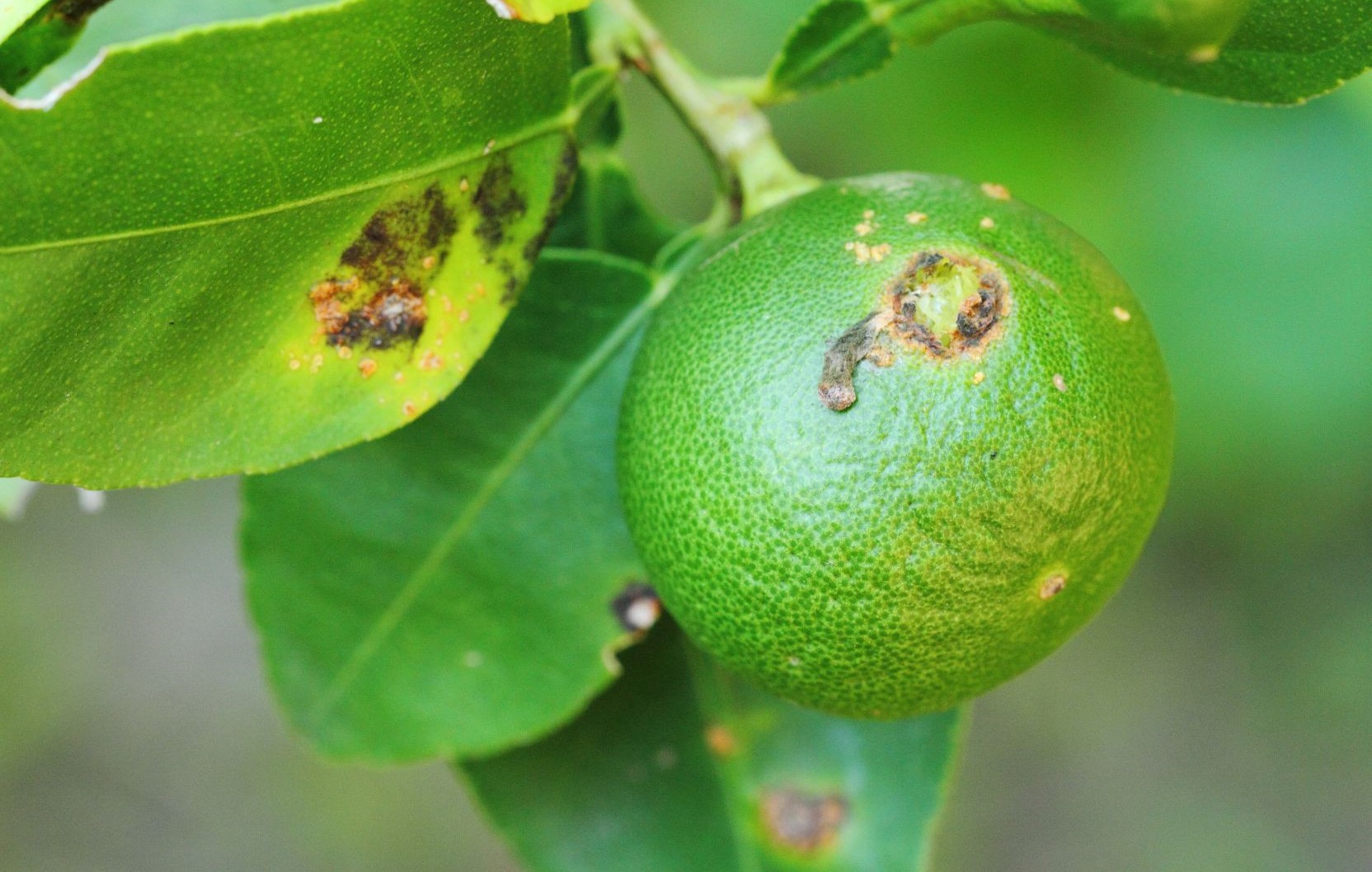Bacterial Citrus Diseases: Identification and Control
What are the most important bacterial diseases that affect citrus trees?
1. Citrus Canker
What is Citrus Canker, and how does it affect citrus trees?
Citrus canker (CC) is a disease caused by the bacterium Xanthomonas axonopodis (syn X. campestris). This species includes three pathovars (bacterial sets of strains with the same/similar characteristics). The strain X. axonopodis pv. citri causes the most severe and widespread disease, CC-A (Asiatic citrus canker), and has been reported in citrus cultivars in Oman, Saudi Arabia, Iran, India, southwest Asia, and Florida. Other strains of this bacterium also cause disease in lemons, Mexican limes, sour oranges, and pummelo in South America, as well as grapefruit and trifoliate oranges. Symptoms include the formation of fruit and leaf blemishes. Infested fruits show dark brown to black raised lesions. Under favorable conditions, defoliation, shoot die-back, and fruit drop can occur.
Common symptoms of Citrus canker
This pathogenic bacterium first appears on the lower leaf surfaces, developing light-colored, pin-point lesions that become raised, tan-colored pustules over time. By that stage, the lesions are visible on the upper leaf surface and might also be surrounded by a chlorotic halo. Eventually, the lesions take a corky or spongy crater-like appearance. Their size depends on the citrus cultivar and the age of the tree, but it generally ranges between 2 and 10 mm in diameter. Similar lesions occur on twigs and fruits. X. axonopodis entry into the plants occurs directly through the stomata on the leaves or wounds caused by thorns, blowing sand, or even the Asian citrus leaf miner, Phyllocnistis citrella. The pathogen can be dispersed up to 32 m from infected trees by wind-blown rain. Farther dispersal, up to 15 km, is associated with tropical storms and tornadoes. Close observation of the underside of the leaves is advised at regular intervals for early identification and prevention. Farmers cultivating citruses should also check for leaf miners and use biological control methods against them. Always seek the advice of local agronomists. Farmers can use the above description of the symptoms and the images for identification to take immediate action against this disease. 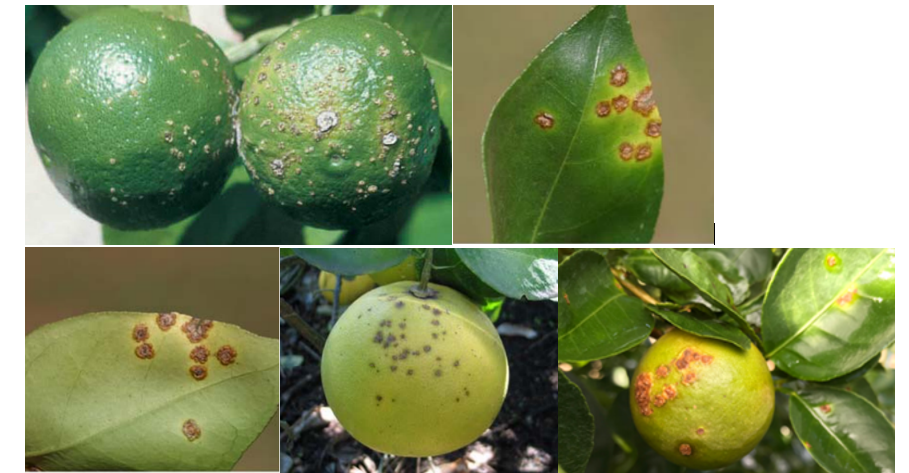
Citrus Canker Symptoms
How to prevent and treat Citrus Canker – infected citrus trees?
- Exclusion through ongoing inspections of nurseries and orchards
- Quarantine of infected trees
- Eradication campaigns on a local scale
- Plantation of non-citrus tree/shrub as a windbreak (e.g. saw pine, red cedar, eucalyptus)
- Leafminer biological control (during periods of flush growth)
- Regular application of copper sprays three times a year at 30-day intervals
2. Citrus Greening or Citrus Huanglongbing
What is Citrus Greening, and how does it affect citrus trees?
Citrus greening (HLB), or yellow-shoot disease, is one of citrus’s most extensively studied bacterial diseases. It is caused by a prokaryote of the phylum Proteobacteria named Candidatus liberibacter. It attacks the phloem (nutrient transportation vessels of trees) of citruses. Transmission of this disease occurs via an insect vector. Citrus Greening infections caused by the heat-tolerant forms of the bacterium (Ca. Liberibacter asiaticus & Ca. Liberibacter americanus), are vectored by the Asian citrus psyllid (Diaphorina citri).
On the other hand, the African form of Citrus Green, is caused by Ca. L. africanus, is a heat-sensitive form that is vectored by the African citrus psyllid (Trioza erytreae). Young trees exhibit symptoms, including the appearance of a yellow shoot composed of blotchy, mottled leaves, which later progress across the entire tree canopy. Young diseased trees never manage to produce fruits.
Common Citrus Greening symptoms
Disease symptoms in older trees are first confined to the initial area of infection, while the remaining canopy shows normal vegetative growth and fruit production. Over time, yellowing spreads across the tree, the foliage becomes sparse, and the tree cannot produce fruits. Asia shows worse cases of die-back and overall decline than other regions. The premature shedding of green fruits is associated with the spotted foliar symptoms, hence the name ‘greening.’ Fruits that remain on the tree are small, misshaped, contain aborded seeds, and only mature on one side. They are also inedible, very acidic, and bitter.
The disease has been observed in the Indian subcontinent, China, Southeast Asia, East Africa, Cameroon, Madagascar, Reunion and Mauritius islands, and the southwest Arabian Peninsula. 2004 HLB was recorded in Sao Paulo, Brazil, Florida, and the USA. Farmers should focus on eliminating the psyllid vector using biological control methods even before the appearance of symptoms. 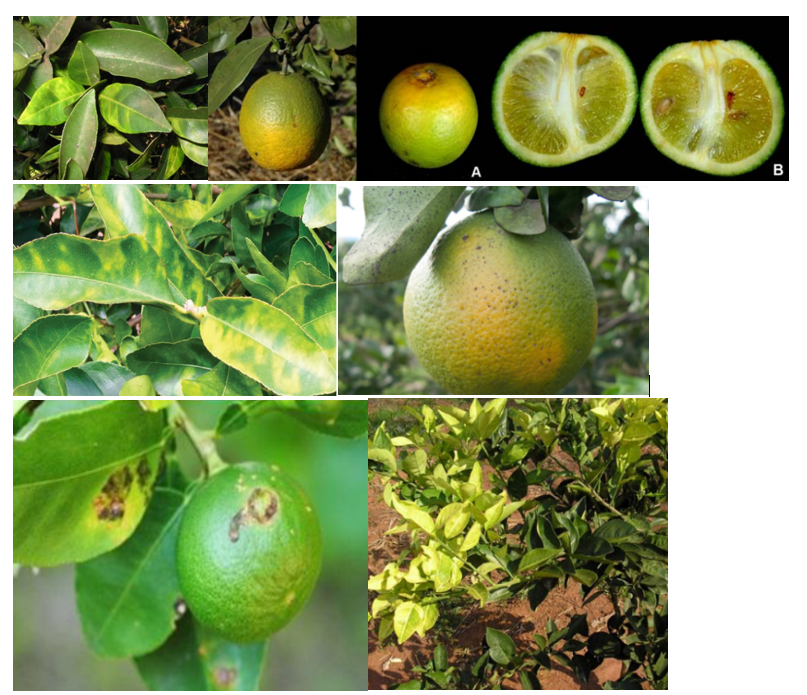
Citrus greening disease
How to treat Huanglongbing–infected citrus trees?
- Integrated-pest-management strategies
- Establishment of orchards with disease-free materials
- Scouting of citrus and non-citrus hosts for identification and removal of infected branches/trees
- Psyllid control programs employing insecticides or biological control agents
3. Citrus Stubborn
What is Citrus Stubborn, and how does it affect citrus trees?
Citrus stubborn (CSD) is a bacterial disease caused by Spiroplasma citri. Its mode of action is very similar to the HLB disease, showcasing spotted leaves and misshapen fruits that do not color at the stem ends. S. citri attacks the phloem of citrus trees, meaning that nutrient uptake is affected.
Young trees seem severely stunted, with dense, abnormally upright leaves. Such symptoms are less evident on mature trees. However, fruits become less nutritious and yield less. Another common symptom refers to off-season flowering, resulting in fruits of various ages and sizes at the same time. Although all commercially important citrus species are susceptible to stubborn, the disease is rarely lethal and symptom expression is predominant under warm weather conditions such as in the southwest US, North Africa, the eastern Mediterranean Basin, and the Middle East. 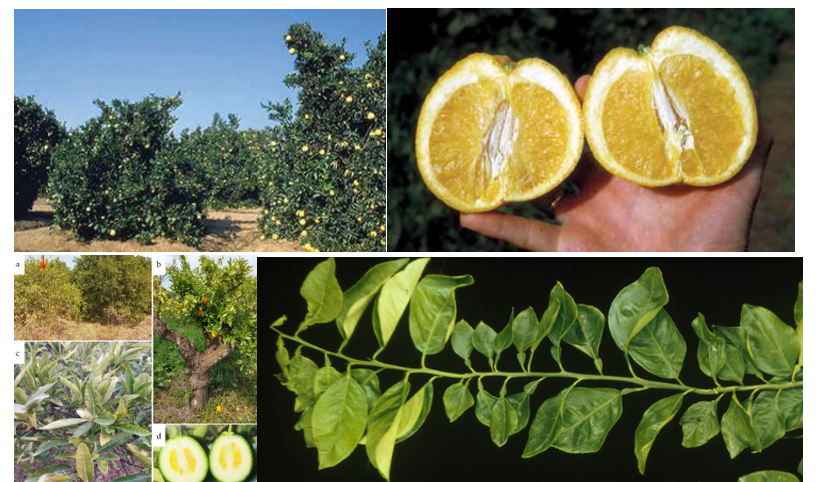
Citrus Stubborn disease symptoms in citrus trees
S. citri spreads via leafhopper vectors (Scaphytopius nitrides, Circulifer tenellus). Many cultivated and wild plants are affected by this disease including members of the families Amaranthaceae, Apocynaceae, Chenopodiceae, Brassicaceae and Plantaginaceae. Citrange (P. trifoliate) is often asymptomatic when infected. The most effective way of Citrus Stubborn disease treatment is the control of the vector.
How to prevent or treat Citrus Stubborn – infected citrus trees?
- Use of disease-free budwood
- Biological control of vector (leafhoppers)
4. Citrus Variegated Chlorosis
What is the Citrus Variegated Chlorosis disease, and how does it affect citrus trees?
Citrus Variegated Chlorosis (CVC) is a bacterial disease that affects citrus trees. It is caused by Xylella fastidiosa, another xanthomonad that is more restricted geographically than the one causing Citrus Canker. Symptoms first appear on the upper surface of leaves and are characterized by chlorotic lesions on young trees between nursery age and ten years. Leaves of trees 15 years and older never become completely affected and often show limited symptom expression on one branch. Over time, small, slightly raised, gummy, necrotic lesions develop on the leave’s underside, corresponding to the upper surface’s chlorotic lesions. Symptoms on fruit are not visible, but their size is greatly reduced, sugar content is increased, and the rind is hardened. Fruit clusters on branches resemble grape clusters. New leaves are also smaller than usual. Trees become stunted, show die-back on twigs, and an overall reduced canopy without completely dying.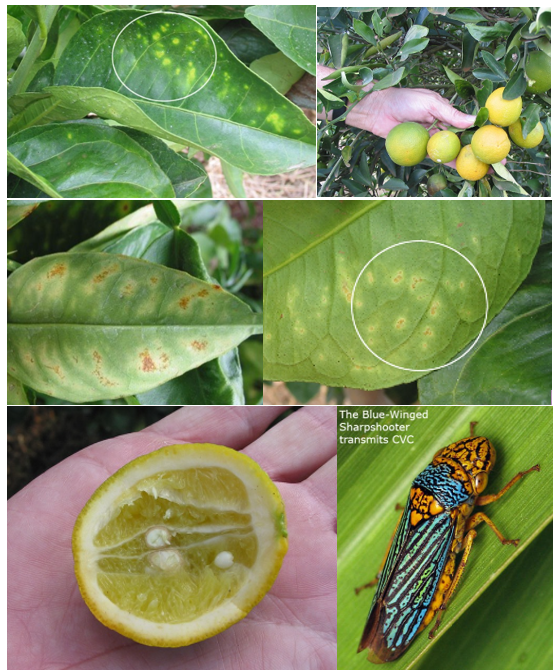
Variegated Chlorosis symptoms in citrus trees and insect vector
Since this bacterium targets the xylem (water transporting vessels), all the symptoms are attributed to water stress. Most of the time, infection occurs due to insect vectors that feed on the sap of the trees. These include xylem-feeding homopteran sharpshooter leafhoppers (fam Cercopidae).
Variegated Chlorosis was originally found in Brazil during the late 1980s. Since then, it has been recorded in all citrus-growing regions of Brazil, Argentina, and Costa Rica. Sweet oranges (Natal, Hamlin, Pera, Valencia) are mostly affected when propagated on the C. limonia, C. reshni, and C. volkameriana rootstocks. Mandarins are moderately resistant. Some weed species are considered reservoirs of infection (Gramineae, Solanaceae, and Compositae weed families).
How to prevent Variegated Chlorosis and treat infected citrus trees?
- Pruning during the early stages of infection, before it becomes systemic
- Testing of asymptomatic ornamentals growing near the orchard
- Growing trees under greenhouse conditions repel sharpshooter leafhoppers
- Removing weed reservoirs of infection from filed
- Biological control of leafhopper vectors
5. Black pit
What is Black Pit, and how does it affect citrus trees?
Black Pit is caused by the bacterium Pseudomonas syringae. It causes water-soaked or reddish-black lesions in the twigs and leaves of most citrus species. Symptoms include small light brown to black pits or larger sunken spots on the fruit, usually 5 to 20 mm in diameter. These pits increase in size during postharvest storage. Ideal conditions for the spread of this disease include prolonged cool and wet conditions and temperatures of 8-20°C. Infection occurs when the bacterium invades the tree tissues through injuries caused by wind, hail, thorns, or heavy rain. Farmers interested in cultivating citrus trees should carefully examine the area’s environmental conditions and avoid locations with increased weather variations since citruses are particularly susceptible to such conditions. The advice of local agronomists should be used in all cases.
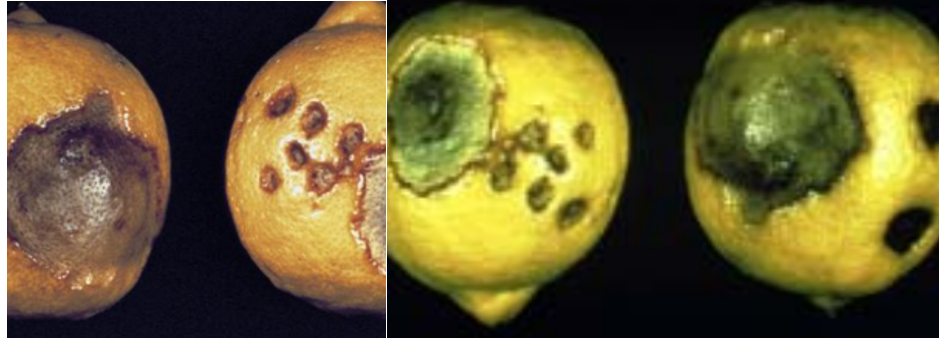
Black pit symptoms in lemons and oranges
Further reading
Fruit-tree related terminology and categorization – Pomology
The most Popular Lemon Tree Varieties
Lemon Tree Pruning for Optimal Growth and Yield
Nutrient needs and Fertilization of Lemon trees
Important Citrus Diseases caused by Fungi
Important Virus Diseases in Citrus trees
Bacterial Citrus Diseases: Identification and Control
References
- Aguilar E, Villalobos W, Moreira L, Rodriguez CM, Kitajima EW, Rivera C (2005) First report of Xylella fastidiosa infecting citrus in Costa Rica, Plant Disease 89, 687
- Bove JM (2006) Huanglongbing: A destructive, newly-emerging, century-old disease of citrus: Journal of Plant Pathology 88, 7-37
- Bove JM, Garnier M (2000) Stubborn In: Timmer LW, Garnsey Sm, Graham JH (Eds) Compendium of Citrus Diseases, American Phytopathological Society, St. Paul , MN, pp 49-50
- Coletta-Filho HD, Takita MA, Targon MLPN, Machado MA (2005) Analysis of 16S Rdna sequences from citrus Huanglongbing bacteria reveal a different Ca. liberibacter strain associated with citrus disease in Sao Paulo. Plant Disease 89, 848-852
- de Graca JV, Korsten L (2004) Citrus Huanglongbing: Review, presend status and fitire strategies In: Naqui SAMH (Ed) Disease of Fruits and Vegetables Diagnosis ad Management (Vol I), Kluwer Academic Publishers, The Netherlands, pp 229-245
- Garnier M, Bove JM (2000) Huanglongbing (Greening) In: Timmer LW, Garnsey SM, Graham JH (Eds) Compendium of Citrus Diseases, American Phytopathological Society Press. St. Paul, MN pp 46-48
- Gottwald Tr, Graham JH, 2000, Canker In: Timmer LW, Garnsey SM, Graham JH (Eds) Compendium of Citrus Diseases, American Phytopathological Society Press, St. Paul MN, pp 5-8
- Growing lemons in Australia, A production Manual, Reader’s note. http://www.dpi.nsw.gov.au/agriculture/horticulture/citrus/lemon-manual
- https://crec.ifas.ufl.edu/research/citrus-production/disease-identification/exotic-citrus/citrus-variegated-chlorosis/
- https://www.cdfa.ca.gov/citrus/pests_diseases/csd.html
- https://www.plantdiseases.org/bacterial-blast-and-black-pit-citrus-lemon
- Hung TH, Wu ML, Su HJ (2201) Identification of the Chinese box orange (Severina buxifolia) as an alternative host of the bacterium causing citrus Huanglongbing, European Journal of Plant Pathology 107, 183-189
- Olson BR, Dominiak J, von Broembsen S, Berg M, Bextine BR (2008) First report of Xylella fastidiosa in Oklahoma, Plant Disease 90, 108
- Sagouti T, Belabess Z, Rhallabi N, Barka EA, Tahiri A, Lahlali R. Citrus Stubborn Disease: Current Insights on an Enigmatic Problem Prevailing in Citrus Orchards. Microorganisms. 2022 Jan 14;10(1):183. doi: 10.3390/microorganisms10010183. PMID: 35056632; PMCID: PMC8779666.
- Sharma, Priyanka & Roy, Monish & Roy, Bidhan. (2021). A Brief Overview of Major Citrus Diseases and Pests and Its Management. 10.9734/bpi/ctas/v1/13548D.
- Stephen, H. Futche and Timmer L., W. 2008, A guide to citrus disease identification, Institute f food and agricultural sciences, University of Florida.
- Tennant et al., 2009. Global Science Books, Tree and Forestry Science and Biotechnology.
- Timmer LW, Gottwald TR, Zitko SE (1991) Bacterial exudation from lesions of Asiatic citrus canker and citrus bacterial spot. Plant Disease 75, 192 – 195
- Zhou LJ, Gabriel DW, Duan YP, Halbert SE, Dixon WN (2007) First report of dodder transmission of Huanglongbing from naturally infected Murraya paniculate to Citrus. Plant Disease 91, 227


















